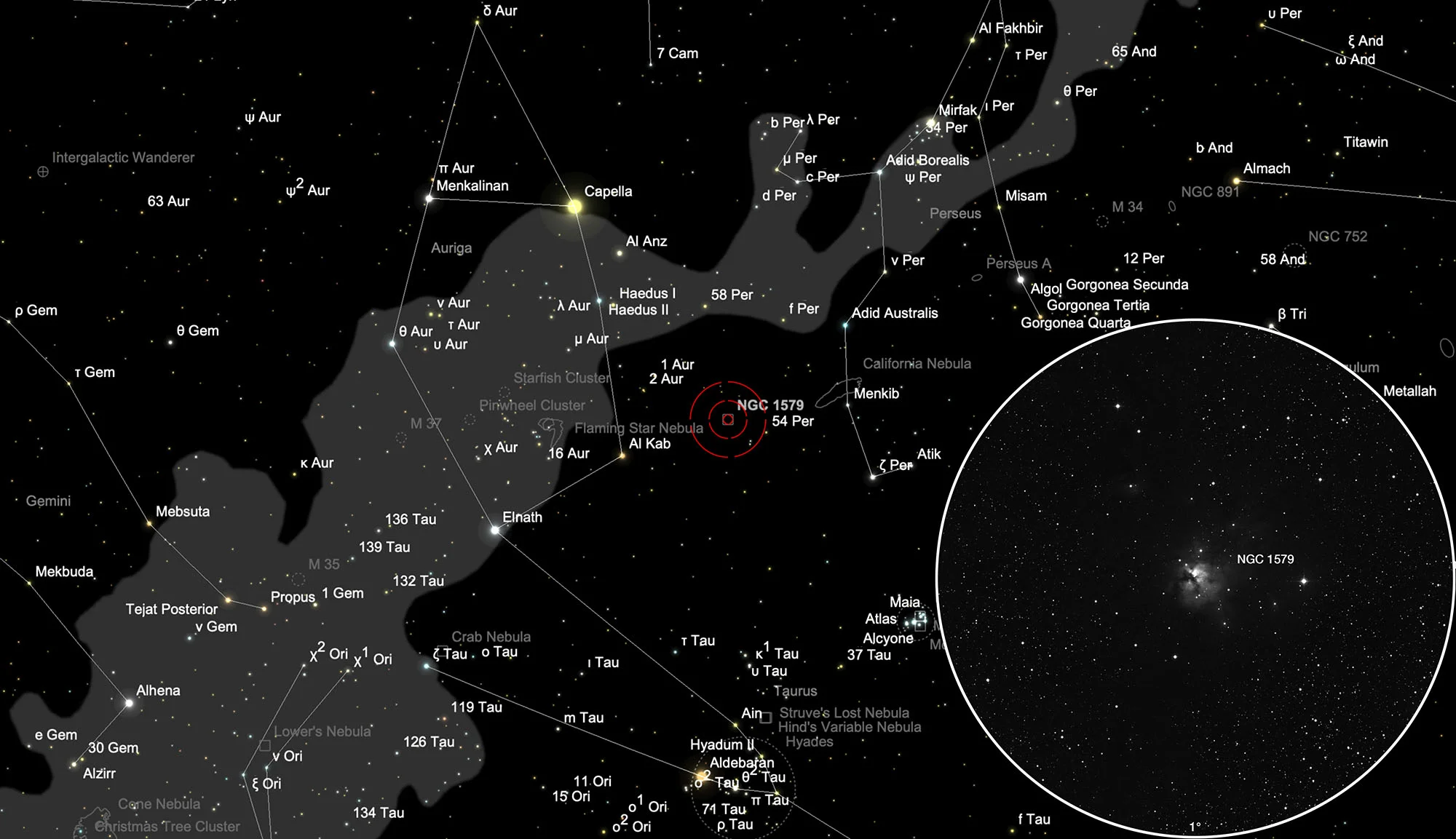Northern Trifid (NGC 1579)

History
The galactic nebula NGC 1579 was discovered on 27 December 1788 by the German-British astronomer William Herschel. He listed it in his catalog as WH I 217. John LE Dreyer recorded the nebula as NGC 1579 in his «New General Catalogue of Nebulae and Clusters of Stars» published in 1888 and described it as follows: «Quite bright, very large, irregularly round, much brighter in the middle, star 8. Size at a distance of 2 arc minutes at a position angle of 350°». [196, 313]
Physical Properties

The name «Northern Trifid» or «Trifid of the North» is inspired by the better known Trifid Nebula (Messier 20), which lies much further south in the constellation Sagittarius. The nebula shows a similar appearance of swirling clouds of gas and dust. This is a large, dusty region in which new stars are formed. These young stars are very hot and therefore shine with a high proportion of blue and ultraviolet light. The high-energy radiation emitted in their short life makes the surrounding gas nebula glow. Many such H-II regions have lumpy, irregular shapes formed by the strong stellar winds of the young stars. Their lifespan is relatively short as the stars blow away gas and dust over time and only stars remain. [353]

The central region of the dark cloud L1482 is illuminated by the star LkHα 101, which is about 8000 times brighter than the sun. Spectral and radio observations suggest that this hot star is surrounded by a small H-II region within a thick cloud of dust. Around 35 much weaker stars were discovered in the cloud, the color-brightness distribution of which suggests an age of around 500'000 years. There are also at least five bright B-type stars of roughly the same age. [354] NGC 1579 resides within a gigantic molecular cloud known as the California Molecular Cloud, named after the California Nebula, which is its most prominent feature. [355] The distance from NGC 1579 to Earth is about 730 parsecs, about 2400 light years. [145]
| Designation | NGC 1579 |
| Type | RN |
| Right Ascension (J2000.0) | 04h 30m 14.2s |
| Declination (J2000.0) | +35° 16' 47" |
| Diameter | 12 × 8 arcmin |
| Metric Distance | 0.800 kpc |
| Dreyer Description | pB, vL, iR, mbM, * 8 350°, 2' |
| Identification, Remarks | WH I 217; h 315; GC 853; LBN 766; Sh2-222 |
Finder Chart
The galactic nebula NGC 1579 is located in the constellation Perseus. The best time to observe is July to May, when the circumpolar constellation is highest at night.
Visual Observation
400 mm aperture: With a 21 mm Ethos eyepiece (85x) and without a filter, a triangular nebula can be seen. An O-III filter does not bring any improvement. With a 9 mm Nagler eyepiece (200x), some structure can be seen in the nebula. — Taurus T400 f/4.5 Dobsonian, Hasliberg Reuti, 6. 11. 2021, Bernd Nies
762 mm aperture: Trifid nebula of the north is reminiscent with its three parted dark spots on his southern partner. — 30" f/3.3 Slipstream Dobsonian, Hasliberg Reuti, 6. 11. 2021, Eduard von Bergen
